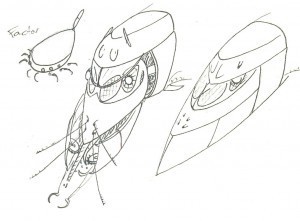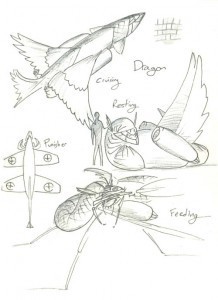Daniel M. Bensen's Blog, page 92
March 8, 2015
91 Book Launching with Carrie Patel

http://www.thekingdomsofevil.com/wp-content/uploads/2015/03/91Carrie.mp3
I’m talking with Carrie Patel, author of the Buried Life, about book launches.
I’ve talked with Carrie before about her steampunk-ish, noir-ish, fantasy-ish, dystopian-ish, book-ish underground thing, but that was when we thought it was coming out in summer 2014. Now, the Buried Life is finally ready for launch (you can buy it now, in fact!).
What are blurbs and how do you get them?
The delightful Beth Cato and the big-named Cherie Priest both think you ought to read The Buried Life.
Caroline Lambe at Angry Robot
Chuck Wendig‘s interesting tweet about publishers:
One thing is for sure, as I said earlier: the best thing an author can get for her book is actual publisher investment in it.
— Chuck Wendig (@ChuckWendig) February 17, 2015
If it feels like you’re using recycled material…don’t
Sending out ARCs
Mysterious Galaxy bookstore, which does fantastic author events
Find bookstores that love the kind of things you write
Mary Robinette Kowal talks about reading fiction aloud (video)
Demographic shifts…for example?
Cracked.com responds to the two stars of 50 Shades of Grey in their “interview.”
Kaja Foglio of Girl Genius fame would probably be doing all that cosplaying, card-playing, and fainting anyway.
“Let me sell you your interests” vrs. “Come play with me!”
March 5, 2015
The Digital Angels of our Nature
Need to make a moral decision? There’s an app for that. But will using the app make you a better person? Or will externalizing your conscience allow you to ignore it?
Robert called up his moral pantheon. Tiny angels, priests, imams, lamas, and secular humanists lounged and debated on the slopes his shoulders and, eventually, reached consensus. There was no reason, in any coherent moral system, for him to pull the trigger.
Robert smiled. He was free to act.
~~~
By the way, you really ought to read Steven Pinker’s Better Angels of Our Nature
March 4, 2015
Tumblr =/= pageviews
On my ongoing mission to answer the question: is Tumblr just a fun way to waste of time, or waste a lot of time? Several months ago, I quoted the extremely clever Steven Pinker saying something extremely clever:
http://danbensen.tumblr.com/post/108182991566/the-idea-that-eskimos-pay-more-attention-to
Last week, lots of people on tumblr agreed that that quote was clever, and they shared it with their friends. A lot of friends.

See that huge spike from my baseline of, like, nothing up into the hundreds? Wow!
But then, see how it immediately went back down to nothing? And only generated one new follower?
And see this?
 This is a google analytics graph for referrals from tumblr during the same time frame. Notice how during the 2/28-3/1 time frame of the explosion of my post’s popularity on tumblr, I got a grand total of a single pageview. That person spent 0 seconds on my site.
This is a google analytics graph for referrals from tumblr during the same time frame. Notice how during the 2/28-3/1 time frame of the explosion of my post’s popularity on tumblr, I got a grand total of a single pageview. That person spent 0 seconds on my site.
So what have I learned today? Tumblr explosions do not necessarily equal explosions of popularity in any way that matters. People reblog a cool post they saw on tumblr, but they don’t track that post back to its source, look up the author of that source, and jump to the author’s homepage, however dazzling in its genius that homepage may be. Moving forward, here’s what I’m going to do from now on:
1) Tie more of my posts to my real work (or at least admit that when I don’t, I’m not working, but fooling around on tumblr)
2) Make sure to link on my site in the body of the tumblr post
3) Continue a steady stream of good content so people follow me
4) Keep telling myself I’m not just fooling around and procrastinating when I use tumblr.
March 3, 2015
Fantasy Gods
I know this is a bit presumptuous, but can I speculate a little about your gods?
I’m re-reading the Chalion books right now, trying to capture some of their essence for my own novel, and I am struck with a paradox. How can there be multiple religions in a world where the gods literally talk to people? Perhaps the Quintarions are simply the most correct in their understanding of the universe than the Quadrenes. I think, however, that the Quadrenes would argue that point.
Imagine a Quadrene pilgrim and merchant, someone who has read and traveled, speaking on the subject of the Bastard:
“The problem with the Bastard is not, as the simple-of-faith say, that he is a demon. The problem is that he is not a god. If he appeared before me in all his splendor (as he reportedly does even to Quadrenes), I might listen to him as a source of wisdom, but I would not owe him allegiance, in the same way I do not owe allegiance to a foreign prince.
“Why should that fact incense you so? I worship five gods, you worship four, and others worship different numbers. Beyond the Archipelago to the far north, where there is no spring and autumn, but only the wet and dry season, what gods do they worship? What of happy denizens of the sunny islands where the climate is always and unchangingly fair?
“If we imagine a universe were spirit is a basic ingredient along with matter and energy, it is easy to see how a chaotic “phase” of spirit might separate from, an orderly one. These phases might be sentient (since labeling something orderly versus chaotic requires an act of judgment), but they might simply be operating under their own rules, the results of which only seem to be sentient. I suppose the same could be said for you and I.
“In any case, if the orderly phase of spirit conglomerates into types according to its internal nature, then I must be correct that there are four gods and you mistaken. Or perhaps both of us are mistaken and the jungle-dwelling Binarians are in the right. Or maybe all of us, mothers, fathers, sons, daughters, and the rest, in dying, group like-with-like to construct our gods, not as personages but as…armies? Political factions? Corporations? Finally, if that is not blasphemous enough for you, suppose gods are like dreams, which all of us have, but all interpret differently. What is objectively simply a massive outpouring (Upwelling? Inrushing?) of order into the world is stamped with the label we are taught to apply.
“In summation, my friend, I think it best you put your sword down, that we may discuss our shared beliefs more fruitfully.”
March 1, 2015
No thanks, I Decline.

Japanese Braille text from Tips for Language Learning tumblr
I noticed something interesting about the Japanese and spaces. Normally, written Japanese has no spaces.
Consider the first sentence in the page above: ティラノサウルスは 最も 大きな 肉食 恐竜です. Preserving the spaces between the words, that is, “Tairanosaurusuwa mottomo ookina nikushoku kyouryuudes.” Translated word-for-word, that’s “Tyrannosaurus-subject-particle most large-adjective carnivore dinosaur-is” or “Tyrannosaurus is the largest carnivorous dinosaur.”
However, the sentence wouldn’t appear like that in a text for sighted adults. It would appear without spaces, like this ティラノサウルスは 最も大きな肉食恐竜です. That’s impossible in Braille, because 恐竜 (“dinosaur” in kanji) and きょうりゅう (“dinosaur” in hiragana) are written the same, and without kanji to break up the flow of phonetic symbols into words, you get the incomprehensible: Tairanosaurusuwamottomoookinanikushokukyouryuudesu.
The funny thing is that if you want to transliterate Japanese into Roman letters, you have to do the same thing. But English speakers do not chop up the sentence the same way. Rather than stick the particles and other grammatical elements onto the ends of the words they modify, as the author of the book above did, English-speakers tend to let them stand on their own, as if they were prepositions: “Tairanosaurusu wa mottomo ooki na nikushoku kyouryuu des.”
On the one hand, it makes no difference. Whether you write “Tairanosaurusu wa” or “Tairanosaurusuwa,” both are pronounced the same, both mean the same thing, and nobody writes it that way in Japan, anyway.
But in terms of language-acquisition, such distinctions might mean the difference between spending all month trying to wrap your brain around weird Japanese grammar and understanding it intuitively in the first lesson.
Let’s say you’re in a Japanese class and your teacher writes on the board: “お会いできるのを楽しみにしています” (I’m looking forward to being able to meet you)
Then your teacher has to transliterate that sentence for the benefit of the students. English-speaking will probably prefer to see this: “oaidekiru no wo tanoshimi ni shiteimasu.” (honorific-be-able-to-meet genitive-particle accusative-particle pleasure locative-particle doing). The student can think “aha, the particle ni is like “in” in English, it just comes after the noun instead of before. It even looks like a backward “in”!
A Turkish or Russian speaker, however, might prefer the method used by Japanese native speakers (when forced to use Roman letters at all) “oaidekirunowo tanoshimini shiteimasu.” (being-able-to-meet-genitive-accusative pleasure-locative doing). Those students can say, “aha! Noun-declension!”
So what’s the difference between the “cases” of Turkish and the “particles” of Japanese? There are some. But I’m willing to be that the honest-to-goodness cases of Turkish and Russian evolved in the same way, from particles that got mashed on to the words that preceded them. Since Japanese native speakers tend to mash their particles in the same way, perhaps it’s only a matter of time until Japanese, like Latin, declines its nouns.
Japanese particles are great!
I noticed something interesting about the Japanese and spaces.
When writing an email, you might write: “お会いできるのを楽しみにしています” (I’m looking forward to being able to meet you)
If you’re like me and you don’t have Japanese language support on your tablet, you’re forced to transliterate everything into Roman letters. But where do you put the spaces?
I would use spaces like this: “oaidekiru no wo tanoshimi ni shiteimasu.” (honorific-be-able-to-meet genitive-particle accusative-particle pleasure locative-particle doing)
But a Japanese native speaker (if forced to use Roman letters at all) would be more likely to write “oaidekirunowo tanoshimini shiteimasu.” (being-able-to-meet-genitive-accusative pleasure-locative doing)
Both sentences would be pronounced exactly the same way, but when you separate the grammatical particles (no, wo, and ni) from the words they modify, you get the idea that they’re separate words like English propositions. When you glue the particles onto the end of the words they modify, though, they start to look a lot like case-endings.
Rather than memorizing “particles” in school, I could have memorized declension tables:
Tanoshimiwa=nominative (Pleasure does something)
Tanoshimino=genitive (of pleasure)
Tanoshimiwo=accusative (Something happens to pleasure)
etc.
Which it strikes me is exactly how people learn Turkish as a foreign language. So what’s the difference between the “cases” of Turkish and the “particles” of Japanese?
February 26, 2015
Kingdom of Clouds
Since no new ideas have occurred to me for a while, I’m going to kickstart the engine by taking a look at New Scientist and seeing how Science is meddling in God’s domain this week. And then think up a way to tell a story about it.
Let’s see here…Okay. Looks like Geoengineering would be ‘irrational and irresponsible’
That is, according to the US National Academies: “sending mirrors into space or putting sulphur dioxide in the stratosphere could have ‘unanticipated, unmanageable and regrettable consequences” on the global climate.'” However, it would be a lot cheaper and faster than all this boring-ass carbon-counting we’re doing now.
So the question is, who’d go for it? Geoengineering (at least for the near future) is probably only going to be a game for national governments. So we need a country with a lot of money, a love of big, expensive, poorly-conceived, ridiculous—it’s China. It’s just. It’s China, guys.
The first idea that comes to mind is a volcano-inducer, perhaps activated in the tectonically active Tibetan plateau. Spew that ash up into the atmosphere, cool the planet, bring industry to an underdeveloped region…but that seems a bit super-villain-ish. Why might such a crazy scheme be a GOOD idea?
Perhaps because the ice caps have melted and Beijing has been flooded? Imagine if you will, a climate-apocalypse story where China is one of the countries that hasn’t collapsed. Before anyone else can object, they induce the volcanoes and begin a Controlled Global Winter.
But when India attempts to seize the volcanoes and cuts off road- and air-access, the only people capable of sneaking into the mountain-top control towers and regaining controls are the local Tibetans.
February 24, 2015
The Anatomy of a Dragon
 As predators of feral von Neumann robots, the feeding apparatus of the Petrolean Dragon must be robust and flexible. When in flight, protective plates interlock to create an aerodynamic profile and protect the delicate sensors. When hunting, these sensors are exposed, along with the feeding and hunting apparatus, which includes pincers, saws, cutting torches, and the distinctive blow-torch.
As predators of feral von Neumann robots, the feeding apparatus of the Petrolean Dragon must be robust and flexible. When in flight, protective plates interlock to create an aerodynamic profile and protect the delicate sensors. When hunting, these sensors are exposed, along with the feeding and hunting apparatus, which includes pincers, saws, cutting torches, and the distinctive blow-torch.
The entire feeding-sensory assembly (or “head”) is manufactured piece by piece in internal fabricators, these pieces swapped out as the dragon grows and moults. Thus, the head is not an integral part of the somatic factor swarm (“body”) and can be removed completely without causing irreversible dissasamebly (“death”). Like the structural chassis (“skeleton”) and internal fabricators (“organs”) the head is a tool manufactured for a purpose by the swarm of finger-nail-sized factors.

A Petrolean Dragon in different modes
Dragons and other so-called “viviperous” mechanoids swap somatic blueprints to generate designs for the next generation. Each partner contributes half of this “genetic” information, but one of the partners is solely responsible for using that information to manufacture the chassis and factors (what would in an animal be flesh and blood) of the offspring. This “female” mechanoid retains its role over the course of its life, although female and male Dragons are not particularly sexually dimorphic.
This reproductive strategy contrasts with that of the “factory-made” mechanoids, which build an enormous nest to churn out more factors (or one might say that a huge factory churns out factors). See also “nomadic-swarm” mechanoids, parasites that hijack the factors of other mechanoids, and were domesticated to create the handshake gauntlets.
Interestingly, nothing like eggs seems to have evolved on Petrolea.
~~~
Some design sketches for the “Petrolean Dragon” from my novella. These were meant to inspire simon-roy in his illustrations, so whatever he comes up with might look totally different from what you see here.
February 22, 2015
90 Dragons! with Dan Koboldt and Tex Thompson
http://www.thekingdomsofevil.com/wp-content/uploads/2015/02/90TexandDan.mp3
I’m talking again with Tex Thompson and Dan Koboldt about dragons. Also some racism and power dynamics in fantasy. But mostly it’s dragons.
You wanna talk about Dragons now?
Jurassic Park meets the Build-a-Bear Workshop
Vann Neuman robots
Nothing gets people fired up like dragons! Ho ho!
The Dragons of Eden by Carl Sagan
The fire in the Song of Ice and Fire
My beef with my little pony
The token normal guy with a sword
Max Gladstone’s Craft Sequence
And that’s why we’re amazing
February 20, 2015
Bulgarian Bibliography
A while ago I met with an ethnologist at Sofia University, who gave me a nifty reading list. I can’t promise I’ll actually be able to read (or even find) all of the resources, but if you’re as interested in 16th-century Bulgaria as I am, you might be interested in:
Ethnography and Folklore:
Etnografiya na Balgaria by Khristo Vakarelski
Anything by Mikhail Arnaudov
Balgarski Folklor by Petar Dinekov
Morphology of the Folktale by Vladimir Propp
Wild Tales by Nikolai Khaitov
Anthology of Bulgarian Poetry by Peter Tempest
The Inn At Antimovo And Legends Of Stara Planina by Yordan Yovkov
History
Anything by Vera Mutafchieva
History of the Bulgarian People by Petar Mutafchiev
Fiction
The Iron Oil Lamp by Dimitar Talev
Elin Pelin short stories
Time of Parting and the movie “Time of Violence” (cause you know, it’s a movie)




